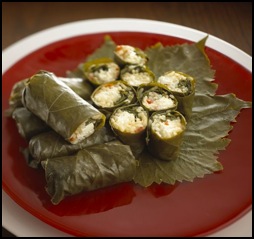
Dolma, strictly speaking, is a stuffed vegetable, that is, a vegetable that is hollowed out and filled with stuffing. This applies to courgette, tomato, pepper, eggplant and the like; stuffed mackerel, squid and mussel are also called "dolma". Dishes involving wrapping leaves such as vine leaves or cabbage leaves around a filling are called 'sarma' though in many languages, the distinction is usually not made. Sarma is derived from the Turkish verb sarmak which means to wrap. Other variants derive from the Turkish word for 'leaf', yaprak.
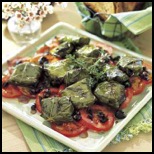
1/2 kg spring onions, finely cut
2 teacups olive oil
200 grams rice
1/2 kg Vine leaves
Pinch salt
2 teacups olive oil
200 grams rice
1/2 kg Vine leaves
Pinch salt
Pinch pepper
Sprigs of dill
Sprigs of parsley
spearmint
Juice of 2 lemons
Sprigs of dill
Sprigs of parsley
spearmint
Juice of 2 lemons
Drain the vineleaves. Sautee the onions in half the oil until they get a golden color. Add the rice, salt, pepper, parsley, dill and spearmint and half a glass of water. Cook until the water is absorbed. Use a tea spoon to count the portion of the rice mixture required for each leaf. Place on each leaf the appropriate portion of rice and then fold each leaf to make a little parcel. In a large sauce pan place the vineleaves one close to each other. Put a plate on top of them in order to prevent them from opening. It is better to cover the surface of the saucepan with some vineleaves to avoid burning of the dolmades during cooking. Add the remaining oil, 2 cups boiling water and the lemon juice. Cook in low heat. The vineleaves are served cold with strained yoghurt.
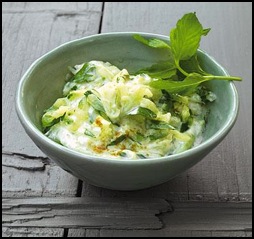
Tsatsiki (Greek: τζατζίκι) is a Greek meze or appetizer, also used as a sauce for souvlaki and gyros. Tzatziki is made of strained yoghurt (usually sheep's-milk or goat's-milk in Greece and Turkey) mixed with cucumbers, a good amount of garlic, salt, usually olive oil, pepper, sometimes dill, sometimes lemon juice and parsley, and sometimes mint added. The cucumbers are either pureed and strained, or seeded and finely diced. Olive oil, olives, and herbs are often used as garnishes.
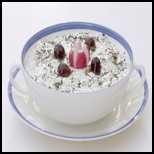
1 English cucumber, peeled
10 cloves garlic, smashed and finely chopped
1 cup distilled white vinegar
4 shallots, thickly sliced
1 cup small, picked sprigs dill
10 cloves garlic, smashed and finely chopped
1 cup distilled white vinegar
4 shallots, thickly sliced
1 cup small, picked sprigs dill
2 1/2 cups strained or Greek yogurt or labne spread
2 tablespoons extra-virgin olive oil
2 tablespoons fresh lemon juice
Kosher salt and cracked black pepper
2 tablespoons extra-virgin olive oil
2 tablespoons fresh lemon juice
Kosher salt and cracked black pepper
Quarter the cucumber lengthwise and trim off the triangular wedge of seeds. Cut the cucumber into a very small, even dice. Transfer it to a mixing bowl. In a food processor, combine the garlic, vinegar, shallots, and dill. Pulse until finely chopped but not puréed. Add the mixture to the cucumbers; add the yogurt. Fold together with a rubber spatula, adding olive oil and lemon juice. Season liberally with kosher salt and pepper, starting off with 1 tablespoon salt. Taste for seasoning. You can store Tzatsiki in a covered, clean jar in the refrigerator for up to 1 week.
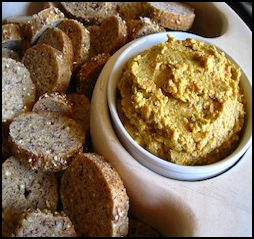
This is a Greek version of hummus that captures the soul of the Mediterranean. Hummus (a transliteration of the Arabic: حمّص; also spelled hamos, houmous, hommos, hommus, hummos, hummous or humus; see romanization of Arabic) is a Levantine Arab[1] dip or spread made from cooked, mashed chickpeas, blended with tahini, olive oil, lemon juice, salt and garlic. It is a popular food throughout the Middle East. Hummus is high in iron and vitamin C, and also has significant amounts of folate and vitamin B6. The chickpeas make it a good source of protein and dietary fiber.
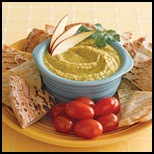
1/2 Spanish or sweet onion, thickly sliced
Extra-virgin olive oil
Kosher salt and cracked black pepper
40 large, plump sun-dried tomatoes (about 2 cups)
6 cloves garlic, smashed
2 large shallots, thickly sliced
Extra-virgin olive oil
Kosher salt and cracked black pepper
40 large, plump sun-dried tomatoes (about 2 cups)
6 cloves garlic, smashed
2 large shallots, thickly sliced
8 leaves basil
1 teaspoon ground cumin
1 cup extra-virgin olive oil
3 tablepoons fresh lemon juice
3 cups Chickpea Confit , drained
1 teaspoon ground cumin
1 cup extra-virgin olive oil
3 tablepoons fresh lemon juice
3 cups Chickpea Confit , drained
Brush the onion slices with a little olive oil and season with kosher salt and pepper. On a hot griddle pan or in a cast-iron skillet, grill until tender and slightly char-marked. In a food processor, combine the grilled onion, sun-dried tomatoes, garlic, shallots, basil, and cumin. Pulse into a chunky purée. With the motor running, slowly drizzle in the olive oil, then the lemon juice. The mixture should be quite smooth. Transfer to a large bowl and add the Chickpea Confit. Fold together to blend. Return to the food processor in batches, and purée until the mixture is smooth and thick. Season to taste with pepper and salt. The texture is a matter of taste; if it is very thick, add a little more olive oil to yield a creamier result.
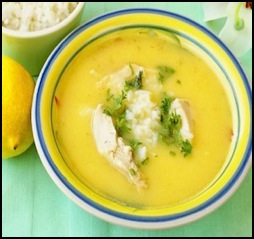
Avgolemono is a Greek soup made with egg and lemon juice mixed with broth, heated until they thicken but before they boil and curdle. Avgolémono translates to "egg-lemon," in English. It is also part of certain stew-like dishes such as the Greek pork with celery and the Turkish yuvarlak, added just before serving to thicken the cooking juices. In other Middle Eastern cuisines, it is used as a sauce for chicken or fish.
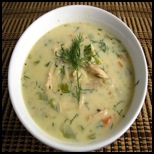
4 cups chicken broth
1/4 cup uncooked orzo (or rice or pastina)
Salt and pepper to taste
3 eggs
3 tablespoons lemon juice
1/4 cup uncooked orzo (or rice or pastina)
Salt and pepper to taste
3 eggs
3 tablespoons lemon juice
1. In a large saucepan, bring the broth to a boil.
2. Add the orzo, rice, or pastina and cook until tender but still al dente, about 7 minutes (20, if using rice). Season with the salt and pepper and reduce heat to low; simmer.
3. Meanwhile, in a medium bowl, whisk together the eggs and lemon juice until smooth.
4. Ladle about 1 cup of the hot broth into the egg-and-lemon mixture, then whisk to combine.
5. Add the mixture back to the simmering saucepan. Stir just until the soup becomes opaque and thickens as the eggs cook, 1 to 2 minutes. Add more salt and pepper, if desired, and serve.
2. Add the orzo, rice, or pastina and cook until tender but still al dente, about 7 minutes (20, if using rice). Season with the salt and pepper and reduce heat to low; simmer.
3. Meanwhile, in a medium bowl, whisk together the eggs and lemon juice until smooth.
4. Ladle about 1 cup of the hot broth into the egg-and-lemon mixture, then whisk to combine.
5. Add the mixture back to the simmering saucepan. Stir just until the soup becomes opaque and thickens as the eggs cook, 1 to 2 minutes. Add more salt and pepper, if desired, and serve.
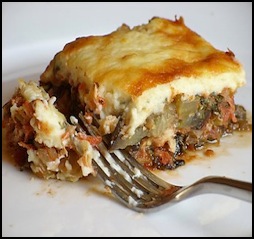
Moussaka: In the usual Greek three-layer recipe, the bottom layer consists of aubergine slices sautéed in olive oil; the middle layer is ground lamb cooked with onion, garlic, chopped tomatoes, herbs, and spices (cinnamon, allspice and black pepper); and the top layer is a béchamel sauce or egg custard (probably introduced by Tselementes in the 1920s). Each layer is cooked on its own and then they are layered in a pan and baked until the top layer is browned. Moussaka is usually served lukewarm, as it keeps its shape better.
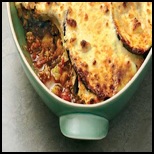
3 1/2 pounds eggplant, unpeeled, cut into 1/2-inch-thick
1/2 cup (about) olive oil
1 large onion, thinly sliced
1 cup finely chopped peeled carrots
1 cup finely chopped celery
4 garlic cloves, minced
1/2 cup (about) olive oil
1 large onion, thinly sliced
1 cup finely chopped peeled carrots
1 cup finely chopped celery
4 garlic cloves, minced
1/4 cup chopped fresh Italian parsley
1 cup grated Parmesan cheese
6 tablespoons (3/4 stick) butter
7 tablespoons all purpose flour
3 1/2 cups whole milk
4 large egg yolks
1 cup grated Parmesan cheese
6 tablespoons (3/4 stick) butter
7 tablespoons all purpose flour
3 1/2 cups whole milk
4 large egg yolks
12 ounces portobello mushrooms, cut into
1/2-inch pieces
1/2 teaspoon ground cinnamon
1 28-ounce can crushed tomatoes with added puree
1 teaspoon dried oregano
1/2-inch pieces
1/2 teaspoon ground cinnamon
1 28-ounce can crushed tomatoes with added puree
1 teaspoon dried oregano
Cover 2 baking sheets with paper towels. Sprinkle both sides of eggplant rounds with salt. Arrange eggplant in single layer atop towels. Let stand 30 minutes. Position first rack in bottom third of oven and second rack in top third of oven and preheat to 425°F. Remove eggplant and paper towels from baking sheets. Pat eggplant dry. Oil same baking sheets. Brush both sides of eggplant rounds with 1/4 cup oil. Arrange in single layer on baking sheets. Bake 10 minutes. Turn eggplant and rotate pans in oven. Continue baking until tender, about 15 minutes longer. Cool. Reduce oven temperature to 350°F. Meanwhile, heat 1/4 cup oil in heavy large skillet over medium-high heat. Add onion, carrots and celery. Sauté until onion is very tender, about 12 minutes. Mix in garlic, then mushrooms. Sauté until juices evaporate, about 10 minutes. Mix in oregano and cinnamon. Add tomatoes and parsley. Cook until.....
mixture is thick, about 10 minutes. Season with salt and pepper. Lightly oil 13x9x2-inch glass baking dish. Arrange half of eggplant rounds in single layer in dish. Spoon half of tomato mixture evenly over eggplant. Sprinkle with 2 tablespoons cheese. Repeat layering with remaining eggplant, tomato mixture and 2 tablespoons cheese. Melt butter in heavy medium saucepan over medium heat. Whisk in flour. Stir 2 minutes. Gradually whisk in milk. Simmer until sauce thickens, stirring constantly, about 5 minutes. Whisk in 1/2 cup cheese. Season with salt and pepper. Whisk yolks in large bowl to blend. Gradually whisk in hot sauce. Pour sauce over vegetables in dish. Sprinkle 1/4 cup cheese over sauce. (Can be made 1 day ahead. Cover; chill.) Bake moussaka until heated through and sauce is golden brown on top, about 45 minutes (or about 55 minutes for refrigerated moussaka). Cool 15 minutes.
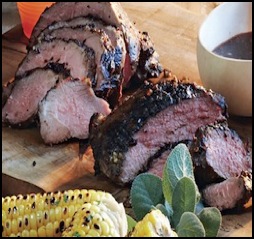
With grilling season in full swing, a nice grilled leg of lamb is a great way to add Mediterranean flavor to your table. Meat from sheep features prominently in several of in the cuisines of the Mediterranean, for example in Greece; in North Africa and the Middle East. While lamb can have a very strong flavor compared to other meats, when cooked properly, it can be fresh and refreshing. Also, served with the right red wine, it can be a stunning meal not soon forgotten.

1/2 cup extra-virgin olive oil
1/4 cup fresh lemon juice
4 garlic cloves, minced
1 tablespoon dried oregano (preferably Greek), crumbled
2 teaspoons salt
1/4 cup fresh lemon juice
4 garlic cloves, minced
1 tablespoon dried oregano (preferably Greek), crumbled
2 teaspoons salt
1 teaspoon black pepper
1 (4 1/2- to 5-lb) butterflied boneless leg of lamb, trimmed of fat
Special equipment: a large (2-gallon) heavy-duty sealable plastic bag; 3 or 4 (10- to 12-inch) metal skewers
1 (4 1/2- to 5-lb) butterflied boneless leg of lamb, trimmed of fat
Special equipment: a large (2-gallon) heavy-duty sealable plastic bag; 3 or 4 (10- to 12-inch) metal skewers
Combine oil, lemon juice, garlic, oregano, salt, and pepper in sealable plastic bag. Add lamb and seal bag, pressing out air. Turn bag to coat lamb, then put bag in a shallow baking pan and marinate, chilled, turning bag over occasionally, at least 8 hours.
Bring lamb to room temperature, about 1 hour, before grilling.
Prepare grill for cooking over direct heat with medium-hot charcoal (moderate heat for gas)
Bring lamb to room temperature, about 1 hour, before grilling.
Prepare grill for cooking over direct heat with medium-hot charcoal (moderate heat for gas)
Remove lamb from marinade (discard marinade) and run 3 or 4 skewers lengthwise through lamb about 2 inches apart. Grill on a lightly oiled grill rack, covered only if using gas grill, turning over occasionally and, if necessary, moving around on grill to avoid flare-ups, until thermometer registers 125 to 128°F, 8 to 14 minutes total for medium-rare.
Transfer lamb to a cutting board and remove skewers. Let lamb stand, loosely covered with foil, 20 minutes. (Internal temperature will rise to 135°F while meat stands.) Cut across the grain into slices.
Transfer lamb to a cutting board and remove skewers. Let lamb stand, loosely covered with foil, 20 minutes. (Internal temperature will rise to 135°F while meat stands.) Cut across the grain into slices.
Contact Us - Newsletter - Membership - Gallery - Press & Media - Terms & Conditions - Help - Site Map ![]()
Corfu Office Tele: 0030-6936604377
Office Hours: Mon - Sat 8am to 2pm and 5pm to 8pm (+2 GMT)
E-Mail: info@corfubyu.com